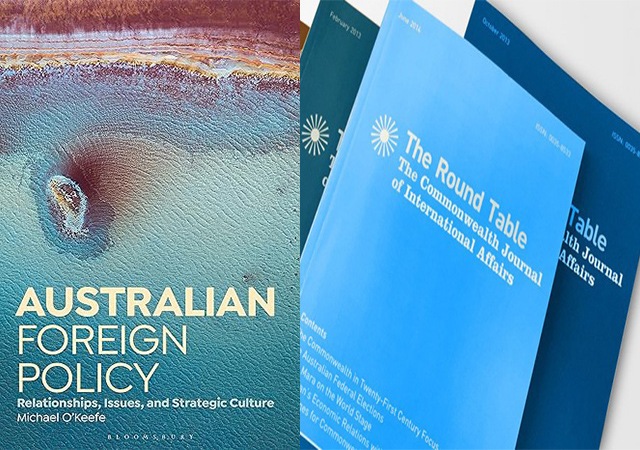
[This is an excerpt from an article in The Round Table: The Commonwealth Journal of International Affairs.]
Whether or not one agrees with the conceptual framework or would like to see some modification, the substantive chapters of the book can be thoroughly recommended, covering Australia’s most significant relationships as they currently stand and are likely to continue in the medium term (as well as the three specifically issue-based chapters). The final sentence in the book about ‘policy inertia with respect to national interest [being] part of Australia’s foreign policy DNA’ (p. 318) perhaps went too far – or, if this is the case, it is a depressing conclusion. One can think of alternative ways of organising a book on Australian foreign policy, but the organisation of this book is quite legitimate. The three chapters specifically on ‘issues’ could easily be extended to frame the book around the big issues of security and economics if one wanted a book that was completely issues-oriented. One would still need to cover the substance as discussed in the chapters on relationships in this book. Another approach would be to focus on regions such as Northeast Asia (China, Japan), Southeast Asia (including Indonesia) and perhaps Europe (including the United Kingdom). The chapters on the South Pacific in this book involve a regional focus. Multilateralism, especially through the United Nations, might receive more extended treatment.
As far as the explanatory power of the conceptual framework is concerned, strategic culture seems most relevant where there is a strong security dimension involved, most obviously with the US and China, but clearly present in all the relationships and issues discussed. In relation to climate change, the author argues that Australia’s modest response has been due to the issue not being sufficiently securitised. By bringing in Realism and Liberal Internationalism (as attitudes) O’Keefe is able to broaden the focus on strategic culture. The relationship among these different perceptions is developed in relation to specific contexts, rather than being overly generalised. In the case of Indonesia there is an argument that geographical proximity rather than strategic culture is the key to understanding Australia’s relationship with that country (p. 158). However, one can argue that Indonesia’s ‘foreignness’ feeds into the assumptions of Australia’s strategic culture. Proximity is an important factor in Australia’s relations with Papua New Guinea and New Zealand, but then other factors (strategic culture perhaps less so) need to be examined in explaining the dynamics of those relationships.
Book review: Australia and the world 1920-1930: Documents on Australian foreign policy
Australia’s 2017 Foreign Policy White Paper: Deconstruction and Critique
I think the book would benefit from a stronger emphasis on the long term historical factors affecting Australian foreign policy, perhaps in the background chapters. This would enable a deeper appreciation of the evolution of Australian foreign policy in relation to the various relationships and issues, including a better understanding of strategic culture. There is reference to 1901, the date of Australian federation, as also being the beginning of Australian independence. The institution of a federal government gave Australia a stronger voice within the British Empire, but Australia’s status was that of a self-governing dominion within that empire, with formal communications being through the Colonial Office (not the Home Office, p. 33) to the Imperial (British) government. Leaders such as prime ministers Alfred Deakin (in the federal government’s first decade) and Billy Hughes (First World War and its aftermath) were important in Australia developing a stronger international presence. However (in line with the strategic culture argument) the preference was for Australia to remain closely aligned with the British Empire, meaning primarily Britain. Australian governments were reluctant to support greater dominion independence as promoted particularly by South Africa, Canada and the Irish Free State. The Statute of Westminster in 1931 formalised dominion independence, with implementation being dependent on ratification by the dominion concerned. In Australia’s case this did not come until 1942, and then mainly for technical reasons. As late as 1944 prime minister John Curtin argued for a united (British) Commonwealth foreign policy.
In relation to Commonwealth matters (a particular focus for The Round Table) it is no surprise that issues specifically relating to the Commonwealth of Nations in its contemporary form do not warrant a mention. However, if one takes a wider view and thinks in terms of a ‘Commonwealth world’ one can obtain some insight into Australia’s political culture (a broader term than strategic culture) as it relates to foreign policy. There is significant overlap in terms of attitudes, institutions and ways of doing politics not just between Australia and Britain and the ‘old dominions’, but with many Global South countries that were once part of Britain’s empire. This extends to the South Pacific, keeping in mind that in terms of the Commonwealth connection Australia and New Zealand (as well as Britain) were colonial powers there. Even with the United States, the overlapping attitudes with Australia relate in part to the US’s origins in British North America (the thirteen British colonies). With CHOGM scheduled for Samoa in October 2024, the chapters on the South Pacific in this book can be recommended for the insight they provide into Australia’s relations with this region (eleven Commonwealth members, including Australia and New Zealand).
Derek McDougall is with the School of Social and Political Sciences, University of Melbourne, Melbourne, Australia.
Australian foreign policy: Relationships, issues, and strategic culture by Michael O’Keefe, London, Bloomsbury Academic, 2023.



